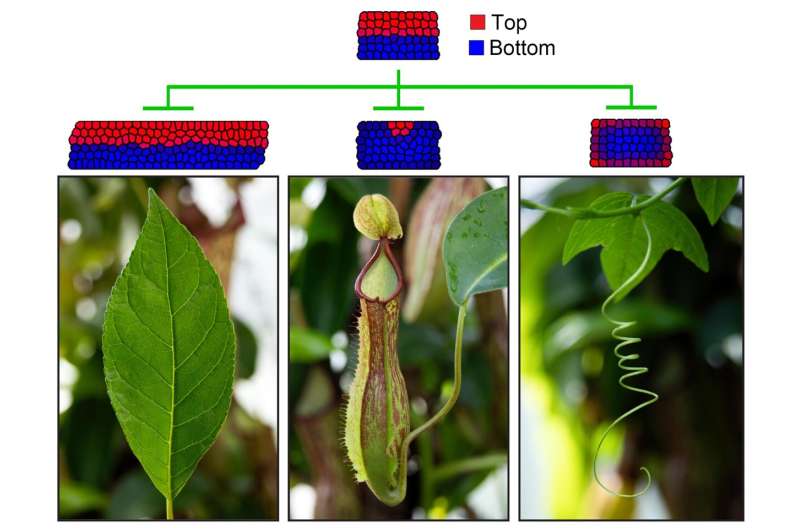This article has been reviewed according to Science X's editorial process and policies. Editors have highlighted the following attributes while ensuring the content's credibility:
fact-checked
trusted source
proofread
How cells in plant leaves organize themselves to ensure optimal area for photosynthesis

Plant leaves need a large surface area to capture sunlight for photosynthesis. Dr. Emanuele Scacchi and Professor Marja Timmermans from the Center for Plant Molecular Biology at the University of Tübingen, together with an international team, have now discovered which genetic mechanisms control leaves' growth into a flat structure capable of efficiently capturing sunlight.
A kind of built-in GPS informs each cell about its relative position in the growing leaf. The order corresponds to a biological concept of self-organization predicted by the famous mathematician Alan Turing. The study on leaf growth has been published in the journal Nature Plants.
"When cells divide and multiply, the result is usually a clump of cells. We wanted to know how, in the case of a leaf, cell division leads to a large flat area," says Scacchi. To this end, a team of mathematicians and experimental biologists worked together to track the processes using computer models, methods of molecular genetics, and imaging techniques on living organisms.
"The basis of such pattern formation is polarity; that is, the ability to distinguish, in this case, between top and bottom. It is usually created by a concentration gradient of a substance, called morphogen, that is low on one side and higher on the other," Scacchi explains.
Autonomous direction
The team discovered that "small RNAs" play a decisive role in controlling the growing leaf. As mobile messengers, they are used for communication between the cells and help the cells to perceive their relative position to each other in the structure—like a GPS. In addition, the small RNAs transmit information that coordinates which genes need to be activated or inhibited on the top and bottom side to give the leaf the right shape and function.
"This regulatory mechanism works autonomously in the growing leaf; there is no central control in the plant," says Timmermans. "We noticed that our results correspond to a theory that Alan Turing put forward more than seven decades ago. Although he is best known for his contributions to computer science, he also dealt with the mysteries of nature."
Turing suggested that simple interactions between certain molecules in the cells of living things can lead to the formation of complex patterns, such as the spots on a leopard's coat or the stripes on a zebra. "He described these processes mathematically in his theory of morphogenesis. Our new study builds on this theory. We have discovered a mechanism controlled by small RNAs that corresponds to Turing's concept of pattern formation via self-organization," says Timmermans.
In this case, self-organization refers to the genetically controlled behavior of the cells, which behave in unison like a flock of birds, forming a collective behavior to create the correct pattern and flat structure of a leaf. Each bird in the flock responds to the movements of its neighbors, and although there is no leader, the collective interactions create a coherent, organized pattern.
Adaptable system
"The small RNA molecules in the cells of the growing leaf set in motion a genetic process that enables the cells to perceive and interpret their environment," says Scacchi. The genes' activities are coordinated among the cells in such a way that each leaf is divided in a sharply defined top and bottom part that form a perfectly flat canvas for photosynthesis.
Such a self-organizing Turing mechanism can adapt gene activity to internal and external disturbances during leaf development, such that leaf shape can be uniform, despite drastic changes in the environment.
"In addition, this genetic system offers many opportunities for fine-tuning. This explains a diversity of leaf shapes observed in nature, from the simple tendril of a climbing plant to the complex pitcher in some carnivorous plants. But our discovery is not only important because it adds a new chapter to Turing's legacy," says Timmermans.
"We have decoded the basic mechanisms by which small RNAs enable self-organizing genetic processes. Now we can explore how humans can modify and harness these biological functions. With a growing global demand for food, we need optimized crops with high yields that are robust against stress factors such as global warming."
More information: Emanuele Scacchi et al, A diffusible small-RNA-based Turing system dynamically coordinates organ polarity, Nature Plants (2024). DOI: 10.1038/s41477-024-01634-x
Provided by Universitaet Tübingen





















